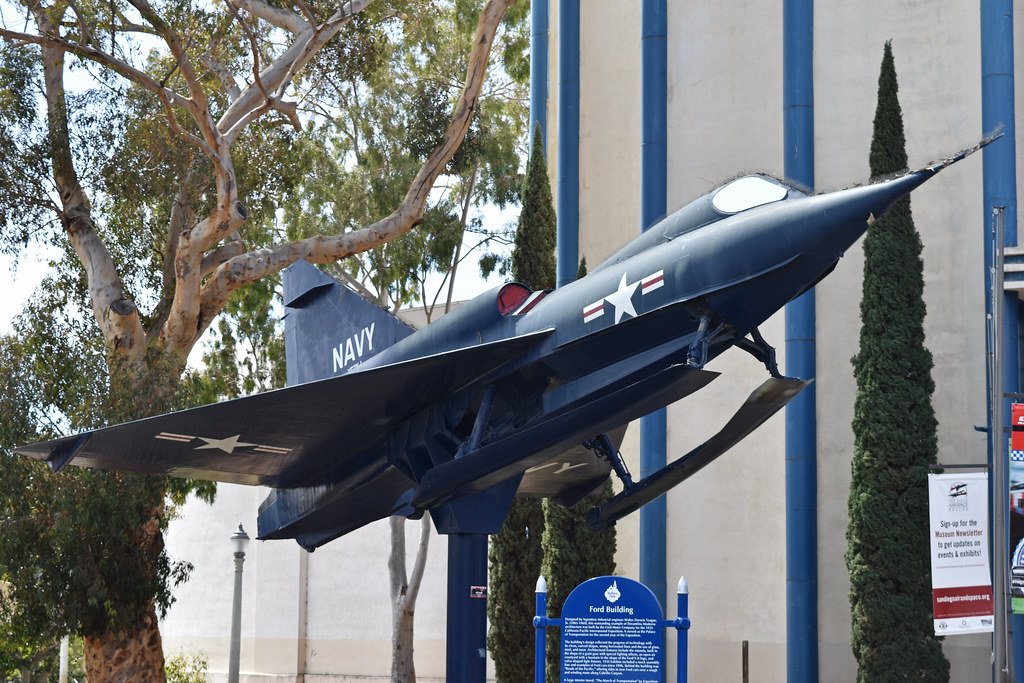#Convair sea dart
Explore tagged Tumblr posts
Text
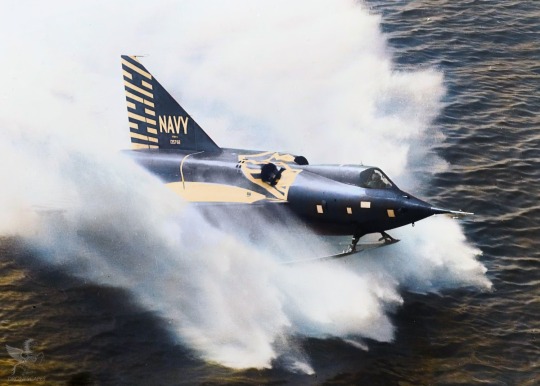
Convair XF2Y Sea Dart, 1954
➤➤ AVIATION ODDITIES: https://youtu.be/wjc_kH147u0
#convair#Sea Dart#Prototype#Supersonic#History#Engineering#Miles Libellula#Convair Sea Dart#youtube#aircraft#airplane#aviation#dronescapes#military#documentary#aviation history
69 notes
·
View notes
Text

A Convair XF2Y-1 Sea Dart (BuNo 137634) on an unknown ship in Panama canal. This Sea Dart was transported to the Maryland Aviation Historical Society and later became part of the Smithsonian Institution collection and is in storage at the Paul Garber Restoration Facility in Suitland, Maryland, awaiting restoration.
Note: "Hold For National Air Museum" painted on the side.
Date: August 1958
source
#Convair XF2Y-1 Sea Dart#XF2Y#Convair XF2Y Sea Dart#Convair XF2Y#Convair F2Y Sea Dart#Convair F2Y#F2Y Sea Dart#F2Y#United States Navy#U.S. Navy#US Navy#USN#Navy#Panama Canal#August#1958#my post
41 notes
·
View notes
Text
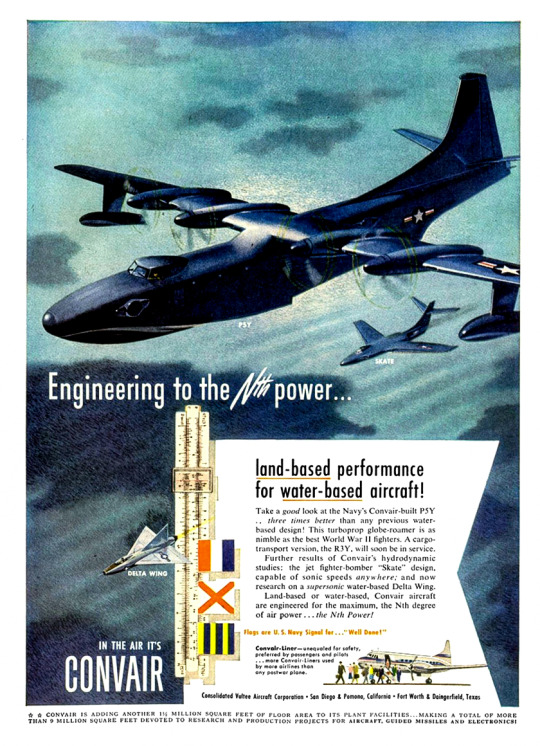
Engineering to the Nth power. In the air it’s Convair - 1952.
#vintage advertising#vintage illustration#convair#convair p5y#convair r3y#convair skate#consolidated vaultee aircraft company#consolidated vaultee#vintage aircraft#military aircraft#commercial aircraft#jet fighters#f-102#f-106#delta dart#delta dagger#sea dart
10 notes
·
View notes
Text

Convair F2Y Sea Dart was an American seaplane fighter aircraft that rode on twin hydro-skis during takeoff and landing. It flew only as a prototype, and never entered mass production. It is the only seaplane to have exceeded the speed of sound.
@ron_eisele via X
9 notes
·
View notes
Video
Convair YF-2Y-1 Sea Dart ‘135763’ by Alan Wilson Via Flickr: The Sea Dart was intended as a jet-powered seaplane fighter and was built by Convair at their San Diego factory. The type first flew in January 1953 and is the only seaplane ever to have exceeded the speed of sound, but it never entered production and only five were built. The first prototype was lost when it broke up during a demonstration in November 1954, killing Convair test pilot Charles E. Richbourg. Only two of the other Sea Darts were ever flown, including this one, but all four airframes still survive. San Diego Air & Space Museum Balboa Park, San Diego, California 18th March 2018
9 notes
·
View notes
Text
Yes, the US Navy did indeed try a let seaplane on skis; gotta love 1950s aviation, "Hey, that's a cool idea, let's try it!" Have a reference,
The aircraft took off and landed on a pair of retractable hydro-skis that extended outward from recesses cut into the lower hull. For takeoff, the skis were initially fully retracted into their wells. Then, as power was applied and the leading edge of the ski broke the water at 9-11 mph, the skis were extended to an intermediate position until 45-55 mph was reached. They were then fully-extended, and the aircraft accelerated to a takeoff speed of about 145 mph. A single ski variant was also tested. The Museum’s Sea Dart was donated by Convair in 1963, but at the time, there was no room for the large, unusually shaped plane at the Museum’s old location on the Del Prado. Thus, the Museum’s Sea Dart languished on Convair’s back lot for 20 years. The Museum’s new location in the Ford Building afforded an ideal spot for the Sea Dart – right in front for all to see. While volunteer craftsmen from Convair undertook to restore the plane, proposals for the plane’s display in front of the Museum were presented for approval by various Balboa Park committees. Final approval was obtained in 1983, and the 12,600 pound aircraft was transported from Convair to the Museum during the early morning hours of June 27, 1984. After the 1.5 hour trip to the park, it was lifted by a crane and pedestal-mounted in front of the Museum. The Museum’s Sea Dart was the third produced by Convair and first flew on March 4, 1955.

22 notes
·
View notes
Text
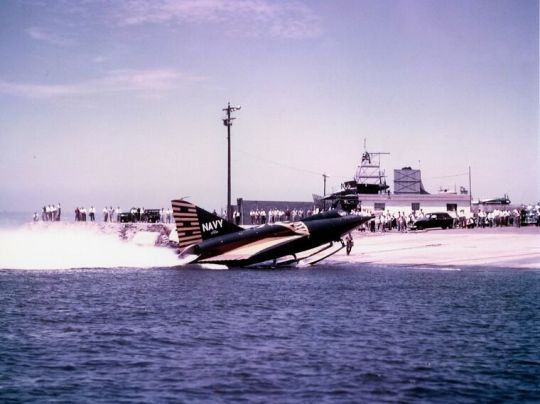
- Convair XF2Y-1 Sea Dart (BuNo 137634) landing on shore. | Photo: US Navy
FLIGHTLINE: 128 - CONVAIR F2Y-1 SEA DART
Designed after WWII, the Sea Dart was the US Navy's first and only supersonic seaplane fighter, though it never saw production.
In the wake of WWII, the US Navy sought a supersonic interceptor aircraft, but doubts about operating jet aircraft, especially supersonic jets, from carriers led to the request for a seaplane interceptor. Convair's design team under Ernest Stout proposed a plane based on the F-102 Delta Dagger, modified with retractable skis.

-Orthograph of the Sea Dart. | Illustration: Convair
In order to reduce the chances of water ingestion, the intakes were moved behind the cockpit, high on the fuselage. The aircraft would sit level in the water, with the wingtips providing floatation for some measure of stability. At 10mph, the skis would extend to an intermediate position, pushing the fuselage out of the water. Between forty-five and fifty-five mph the skis would be fully extended; take off speed would be 145mph. Production aircraft were expected to be fitted with a pair of Westinghouse J46 turbojets, though the prototypes were equipped with J34s instead, as the former were not available. The prototypes were unarmed, but operational F2Ys were to be fitted with four Colt Mk12 20mm cannon and an unspecified number of folding fin aerial rockets; a similar weapons loadout was carried by the F-89 Scorpion and F-94 Starfire.

-Line drawing of the XF2Y-1 prototype with its single ski. | Illustration: blueprints.com
During construction of the XF2Y-1, the contract was altered, eliminating the second prototype and adding 4 service test aircraft (YF2Y) and eight production F2Y models. The prototype was also fitted with a single larger ski compared to the test types. In December 1952 the XF2Y was transported from Convair's San Diego factory to San Diego Bay for testing. On 14 January 1953 it achieved a short flight during taxi testing, with the first official flight occurring on 9 April.

-The XF2Y with a trailer and access ladder. | Photo: US Navy
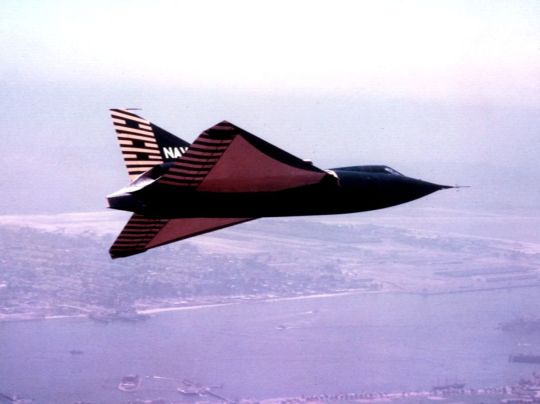
-The XF2Y in flight over San Diego. The yellow markings against the dark blue provided a reference of the aircraft's attitude for engineers. | Photo: US Navy
Flight testing on the XF2Y showed that the plane was (as expected) underpowered with the J34 engines, and was unable to exceed Mach 1. The design, based on the pre-area rulled F-102 fuselage, generated excessive drag, which only exacerbated the issue. In addition, the hydroskis proved to be less effective than hoped, and even with the shock-absorbing oleo legs the aircraft experienced jarring vibrations during takeoffs and landings. Engineers attempted to correct the flaws by refining the ski design, switching to two skis, removing the beaching wheels, and changing the oleo legs, but the vibration issue was never fully solved.
With the cancellation of the second XF2Y, the first two YF2Y test types were fitted with J46s engines and began their test program in 1954. Unfortunately, the J46 proved to also be underpowered, and the Sea Dart was still unable to exceed Mach 1 in level flight. That said, the aircraft did go supersonic on several flights by executing a shallow dive, making it the sole seaplane to break the sound barrier. Tragedy struck on 4 November 1954, when Convair test pilot Charles Richbourg was killed during a demonstration flight. YF2Y-1 BuNo 135762 broke apart in mid-air when the aircraft's structural limitations were exceeded. This accident, combined with lingering issues with the hydroski design and advancing technology allowing supersonic jets to fly from carriers saw the Sea Dart project relegated to experimental status, with the eight production aircraft cancelled and the last two test aircraft completed without engines.
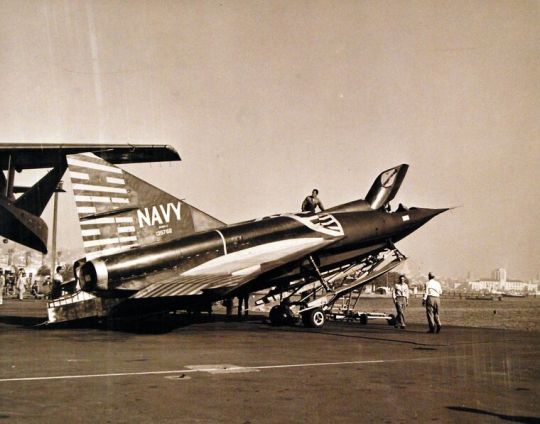
-One of the last photos of Convair pilot Charles Richbourg and the F2Y prior to their ill-fated flight. Photo: US Navy
Flights of the remaining Sea Darts continued, at a reduced tempo, until 1957 after which the aircraft were placed into storage. For this reason, the aircraft were still technically "on the books" in 1962 and were thus redesignated the YF-7A under the Tri-Service scheme, even though they had not flown for some 5 years. One XF2Y prototype and three YF2Y test aircraft survive, on display across the US:
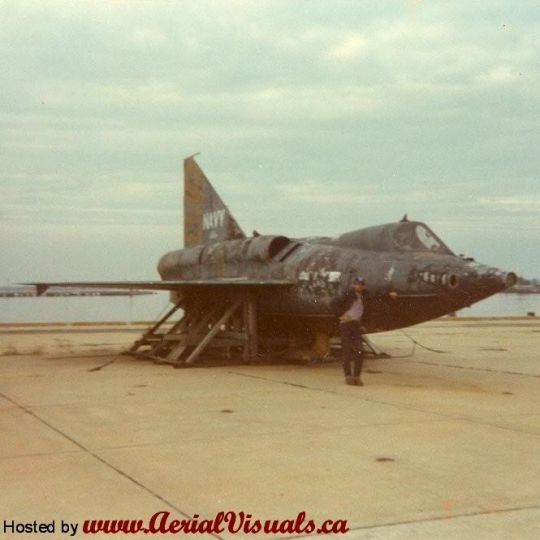
-XF2Y-1 Sea Dart, Bureau Number 137634, is in bad shape due to a mistake with a crane and is awaiting restoration for the Smithsonian Institution in Washington D.C..

-YF2Y-1 Sea Dart, Bureau Number 135763, is on display at the San Diego Air & Space Museum in Balboa Park.

-YF2Y-1 Sea Dart, Bureau Number 135764, is on display at the Wings of Freedom Aviation Museum at NAS Willow Grove, Pennsylvania.

-YF2Y-1 Sea Dart, Bureau Number 135765, is on display at the Florida Air Museum
#aircraft#aviation#avgeek#cold war#airplanes#airplane#cold war history#coldwar#aviation history#navy#us navy#f2y#Convair f2y#Convair sea dart#sea dart#f2y sea dart#xf2y#yf2y#yf7a#yf 7a#Convair#seaplane#sea plane
69 notes
·
View notes
Text
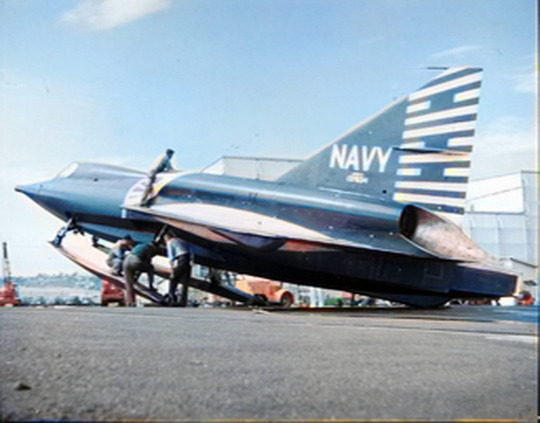
Convair XF2Y Sea Dart parked at Lindbergh Field in Convair's San Diego, California facility.
SDASM: 01_00083857
#Convair XF2Y-1 Sea Dart#XF2Y#Convair XF2Y Sea Dart#Convair XF2Y#Convair F2Y Sea Dart#Convair F2Y#F2Y Sea Dart#F2Y#United States Navy#U.S. Navy#US Navy#USN#Navy#San Diego#California#1950s#my post#Lindbergh Field
31 notes
·
View notes
Text
fuck it ill do it myself
Bellanca Aircruiser, from what I can tell this appears to be the 66/75 variant
Convair F2Y Sea Dart
Beecraft Wee Bee
Seems like a personal project that happened to have a photo shared, can't even find who made it anywhere
Lockheed Martin P-791 Airship
Condor Scnark ZK-JEK, made in New Zealand, seemingly by a single person with the goal of making a 2 seater microlight
Little Wing Autogyro, the name is literally in the picture it's not hard to find
Hiller X-18 Convertiplane experimental cargo transport
Boeing L-15/YL-15 Scout
Rose Hereth/David Rose RP-4, an aircraft designed to break the sound barrier using 2 V8s and a dream (though it seems to not yet be completed so it hasn't actually done it yet)
Blohm & Voss BV-141 Tactical Reconnaissance Aircraft
Bartini Berieve VVA-14, a ground effect based, VTOL, amphibious aircraft. It was intended to have inflatable pontoons on outer sections of the fuselage to allow it to land on water, sand, marsh, or basically any other surface, as well as 12 lift jets in two rows along the aircraft body, meant to allow it to have VTOL capabilities so it could take off from anywhere, alongside 2 high power turbofans resting atop the hull to allow it to reach speeds of 760 km/h and altitudes of 33,000 ft using its more conventional wings. Almost none of these features ever came to fruition before the Soviet Union pulled funding to invest in less risky projects while they were on the brink of collapse. oh uh. what were we talking about again?
Bréguet 1050 Alizé
Rutan Model 202 Boomerang
Budd RB-1 Conestoga
MacCready Gossamer Condor, the first ever human powered aircraft. like. flintstones car. but a plane
A modified Northrop F-5 for DARPA sonic boom testing.
Lockheed Martin X-59 QueSST, an aircraft developed by the Lockheed Skunk Works division for NASA's 'Low Boom Flight Demonstrator' project, designed to create a significantly decreased percieved volume sonic boom by using the aircraft shape to direct the majority of it up and into space, away from people on the ground, to demonstrate the possibility for supersonic flight over civilian populations in the current day
Another photo of the Convair F2Y Sea Dart
Lockheed XFV Salmon, a tail sitting VTOL aircraft prototype created to demonstrate VTOL technologies in fighters
Stipa-Caproni, an experimental, barrel shaped aircraft that basically made the entire fuselage a ducted fan
SNECMA C.450 Coléoptère, a tail sitting VTOL aircraft similar to the Lockheed XFV, though with a less conventional annular wing design
McDonnel Douglas MD-81(UHB), a propfan/unducted or open rotor turbofan technology demonstrator, an engine design meant to have the performance of a turbofan with the efficiency of a turboprop, though it never came to fruition due to excessive noise and an inherent decrease in maximum blade tip speed as opposed to a more standard ducted turbofan, though recently CFM International has continued development of technologygy
Hawker Siddley Nimrod (Left: R1, Right: MR2), a British maritime patrol aircraft developed as a modification to the de Havilland Comet, the first ever jet airliner
Lippisch-Dornier Aerodyne, a wingless, VTOL unmanned aerial vehicle
Honda HA-420 HondaJet, a light business jet with unconventional over-the-wing engines, positioned allow for the structure within the aircraft for rear mounted engines, allowing Honda to have a smaller cabin length then they otherwise would've been able to squeeze out of the aircraft while not decreasing (or possibly increasing) the total internal cabin size
Rockwell B-1 Lancer, a supersonic, swing wing, heavy bomber.
Left: Northrop YB-35, an experimental heavy bomber designed to be highly efficient due to the reduced parasitic drag and structural weight not responsible for lift. Right: Northrop YB-49, YB-35s converted to jets as the program stalled due to the US Government not wanting to invest heavily in propellor based aircraft as jet aircraft became more common.
Douglas X-3 Stiletto, an experimental aircraft used to test design features suitable for sustained supersonic flight, including the first use of titanium in major airframe components.
Boeing X-32 "Ugly Duckling", a demonstrator designed to compete in the Joint Strike Fighter program, losing to the Lockheed Martin X-35 (developed into the F-35) due to major design inefficiencies (mainly the inability to fly supersonic and have VTOL capabilities without a long, manual transition between configurations which the X-35 was capable of, automatically, mid flight)
Virgin Galactic SpaceShipTwo VSS Enterprise
Sikorsky S-64 Skycrane
Solar Impulse 2, an experimental solar powered aircraft concept
NASA AD-1, an experimental aircraft designed to test the feasability of an oblique wing design at low speeds (kinda stupid plane because the oblique wings are most beneficial at high (and particularly supersonic) speeds)
Korabl Maket (KM) (Caspian Sea Monster), a Soviet ekranoplan designed as a demonstration for how the ground effect can be used to allow gargantuan aircraft to fly with relative efficiency. Named the Caspian Sea Monster after an American reconnaissance sattelite photographed it resting in a harbour in the Caspian Sea
This appears to be the RC Aircraft PeterStripol made in this video: https://youtube.com/watch?v=hgUlIYeA-7k for Flite Test as one of its wings failed mid flight at 12:30
there, that should be all of them, happy?
weird and unsettling aircraft
#this took me two fucking hours and now my back hurts :(#let me know if i got any of these wrong!#i am happy to learn (and im stupid so i probably did)
556 notes
·
View notes
Photo

1954 Convair XF2Y Sea Dart taking off.
4 notes
·
View notes
Photo

A little indulgent plane-planning for Sanguine Tensor.
First up, some good news for me and bad for you. This month is nutty for me for (mostly!) good reasons. I probably would have finished Aphelion around New Years, but I’m pretty sure I can’t now. I’m fine, just swamped.
So for now all I can show is some alternate history goofy planes.
Top and Top Right: The US in Sanguine Tensor loves seaplanes for some stupid reason (probably a Pearl-Harbor-esque attack that made people feel aircraft carriers too vulnerable). So aircraft carriers are supplemented by fast little attack ships that drop seaplane fighters into the ocean from a gantry. Floats are huge and draggy so they just inflate and deflate thick canvas floats. I was thinking of giving these to the USSR but they have fewer year-round ports available so it makes less sense, they need land based planes (the again... ekranoplan...). I’ll think of something nice and goofy for the Soviets, don’t worry.
Top Left and Lower Right: This practice of little ships that carry fighters continues into the present (well, the eighties). There’s a historical period where people were REALLY concerned about supersonic fighters on carrier aircraft. Supersonic planes tend to land fast and need big runways so if you’re already pretty good at water takeoffs and landings maybe you consider sticking with that instead of controlled crashes into boats. Pitfalls include Oh God There Is Salt Everywhere, How Do I Control This Thing Skimming Over The Sea Without Dying, and Engines Need Air Not Water. Pitfall one, well you just have to deal with the salt, that’s it. Pitfall two is fixed by using hydrofoils to control the aircraft for takeoff and landing. Pitfall three is a little tricky because for high angle-of attack maneuvers you want the engine inlets able to get nice fresh air so putting them high above the wings like the Convair F2Y Sea Dart isn’t desirable. BUT you can open up aux inlets, like the Harrier, JSF or MiG-29. So I think this is all plausible enough and it doesn’t have to be perfect because nobody is paying me for this and it’s just for fun.
Bottom Right: XB-70 style passenger plane. Very loud, very inefficient, very ostentatious, and very cool. Need to think about this more but I am excited.
35 notes
·
View notes
Text
The best part is they actually tried this in the 50s, with the Convair YF2Y Sea Dart, before they realized they could safely operate supersonic aircraft off carriers. It didn't work that well mostly because the actual plane part was pretty badly designed (underpowered and not area ruled) and one disintegrated during an airshow pass.





70 notes
·
View notes
Video
84th FIS Convair F-106A Delta Dart 57-2490 by Wing attack Plan R Via Flickr: F-106A-90-CO. C.N. 8-24-73. Last unit: 186th FIS / 120th FIG, Great Falls IAP. Withdrawn from service to AMARC 1 April, 1987 as AA FN0129. Departed AMARC 19 August, 1991 to American Electronic Laboratories, East Alton, IL., converted to QF-106A (AD 163). Shot down by AIM-120 from a Sea Harrier. Photo Credit's: Unknown to me (reprint scan). Photo was taken in 1975, (with bi-centennial marking on speed brake). 84th FIS was stationed at Castle AFB in this time period.
0 notes






